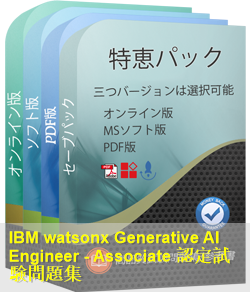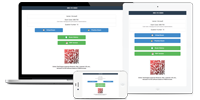C1000-185の迅速なアップデート対応
C1000-185試験に変更がございました場合は、現在の試験と一致するよう、瞬時に学習資料を更新することができます。弊社は、お客様に最高、最新のIBM C1000-185問題集を提供することに専念しています。なお、ご購入いただいた製品は365日間無料でアップデートされます。
ダウンロード可能なインタラクティブC1000-185テストエンジン
IBM Certified watsonx Generative AI Engineer - Associateの基礎準備資料問題集には、IBM Certified watsonx Generative AI Engineer - Associate C1000-185試験を受けるために必要なすべての材料が含まれています。詳細は、正確で論理的なものを作成するために業界の経験を常に使用しているIBM Certified watsonx Generative AI Engineer - Associate によって研究と構成されています。
あなたのC1000-185試験合格を100%保証
JPNTestテスト問題集を初めて使用したときにIBM Certified watsonx Generative AI Engineer - Associate C1000-185試験(IBM watsonx Generative AI Engineer - Associate)に合格されなかった場合は、購入料金を全額ご返金いたします。
JPNTestでIBM C1000-185問題集をチョイスする理由
JPNTestは、1週間で完璧に認定試験を準備することができる、忙しい受験者に最適な問題集を提供しております。 C1000-185の問題集は、IBMの専門家チームがベンダーの推奨する授業要綱を深く分析して作成されました。弊社のC1000-185学習材料を一回のみ使用するだけで、IBM認証試験に合格することができます。
C1000-185はIBMの重要な認証であり、あなたの専門スキルを試す認定でもあります。受験者は、試験を通じて自分の能力を証明したいと考えています。 JPNTest IBM watsonx Generative AI Engineer - Associate は、IBM Certified watsonx Generative AI Engineer - Associateの380の問題と回答を収集して作成しました。IBM watsonx Generative AI Engineer - Associateの知識ポイントをカバーし、候補者の能力を強化するように設計されています。 JPNTest C1000-185受験問題集を使用すると、IBM watsonx Generative AI Engineer - Associateに簡単に合格し、IBM認定を取得して、IBMとしてのキャリアをさらに歩むことができます。
C1000-185試験の品質と価値
JPNTestのIBM Certified watsonx Generative AI Engineer - Associate C1000-185模擬試験問題集は、認定された対象分野の専門家と公開された作成者のみを使用して、最高の技術精度標準に沿って作成されています。
IBM watsonx Generative AI Engineer - Associate 認定 C1000-185 試験問題:
1. You are tasked with fine-tuning a large language model (LLM) on a specific industry dataset using the IBM watsonx user interface. Due to the lack of labeled data, your team decides to generate synthetic data to supplement the training set. The objective is to ensure the fine-tuned model can generalize effectively to real-world scenarios in this industry. You need to configure synthetic data generation and perform the fine-tuning.
Which of the following actions should you take to ensure the synthetic data is suitable for fine-tuning the model and does not lead to overfitting or model bias? (Select two)
A) Ensure that the synthetic data covers edge cases as well as common industry scenarios.
B) Generate only a small amount of synthetic data to minimize computational costs and training time.
C) Rely solely on synthetic data for fine-tuning, as it is fully representative of the industry domain.
D) Use the IBM watsonx Data Refinery tool to inspect and balance the synthetic data before fine-tuning.
E) Configure the synthetic data to exclude rare or uncommon events, as these are not representative of the overall dataset.
2. You are tasked with integrating IBM watsonx with a third-party customer relationship management (CRM) system to enhance customer interactions through conversational AI.
Which of the following approaches best ensures real-time responses while minimizing the latency caused by data exchange between systems?
A) Set up periodic data synchronization between the CRM system and IBM watsonx using FTP file transfers.
B) Employ an asynchronous message queue between IBM watsonx and the CRM system to handle customer requests.
C) Utilize watsonx's real-time streaming API with pre-configured webhooks in the CRM system for instant data retrieval and response.
D) Use IBM watsonx API for batch processing of customer requests, triggering the CRM system via a scheduled job.
3. In a scenario where a developer is creating reusable prompt templates for a Watsonx Generative AI project, what is the most effective method to track the usage and performance of these templates over time?
A) Relying on manual tracking of templates in a spreadsheet for each generation
B) Embedding unique identifiers in the prompt templates and using Watsonx's logging mechanisms
C) Using static prompt templates without any tracking, as tracking adds unnecessary overhead
D) Leveraging Watsonx's native analytics and monitoring tools with built-in prompt tracking features
4. You are tasked with creating a prompt-tuned model using IBM watsonx.ai to enhance the quality of text generation for customer support. The goal is to fine-tune the model for improved context understanding based on specific customer queries.
Which of the following approaches would be the best method to initialize the prompt for tuning?
A) Use a manually crafted prompt tailored to the specific context of customer support queries
B) Use a pre-trained general-purpose prompt with no domain-specific customization
C) Construct a prompt using a large set of random tokens from the training corpus
D) Use a prompt with pre-defined output patterns to restrict the model's possible responses
5. In a generative AI model, you are tasked with producing creative yet coherent text for a marketing campaign. You want to ensure that the output contains varied word choices and diverse sentence structures while still maintaining some degree of logical consistency.
Which of the following settings for the temperature parameter would most likely achieve this balance?
A) Temperature = 0.2
B) Temperature = 0.7
C) Temperature = 2.0
D) Temperature = 0.0
質問と回答:
| 質問 # 1 正解: A、D | 質問 # 2 正解: C | 質問 # 3 正解: B | 質問 # 4 正解: A | 質問 # 5 正解: B |


 403 お客様のコメント
403 お客様のコメント





